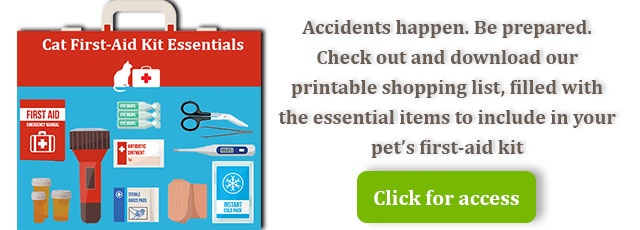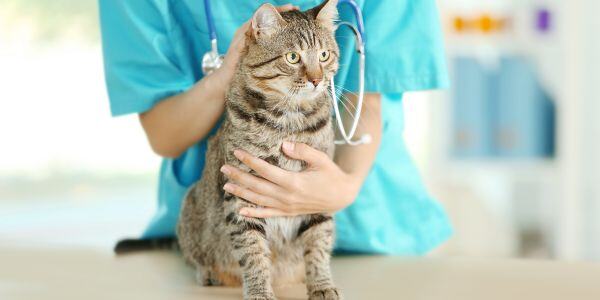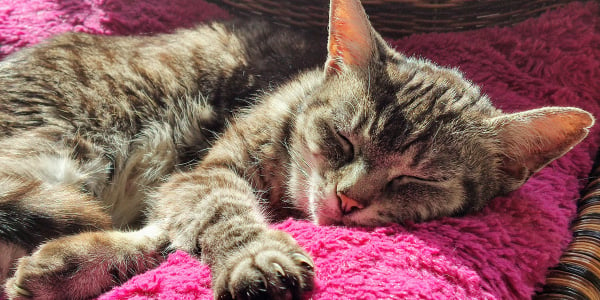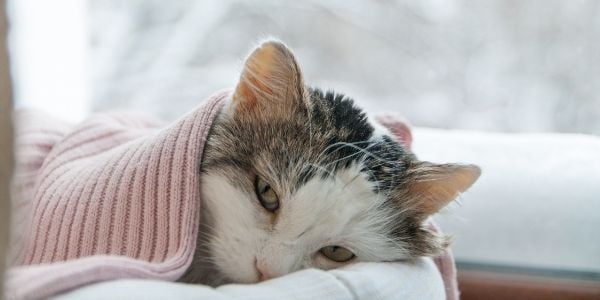
There is nothing more frightening than suddenly noticing something wrong with your beloved cat.
Your first instinct may be to panic and rush to the veterinarian. In some cases, this may be the thing to do.
Not the panic part! But rushing to the vet may be necessary. But when is something a true veterinary "emergency” for your cat?
Some situations may be worrisome but do not require immediate care.
As a veterinarian, I want your cat to receive the best care as soon as possible – not to suffer more than they have to.
But how do you know if it’s an emergency? Do you wait to see your regular veterinarian when they’re open next or rush to the ER? Or do you simply just wait it out and hope things get better?
There is a saying that “cats are not small dogs,” and it is true. Cats have their own unique needs and medical issues and respond much differently than dogs do to illness and injuries.
I have been at the emergency clinic with my own beloved felines when they needed specialized care.
I empathize with that helpless feeling when your fur baby is not well. Hopefully, these tips and insights will help guide your decision-making.
What Is Considered an Emergency for Your Cat?
If Your Cat is Hit by a Car
If your cat has been hit by a car, a veterinarian should always examine them, even if they seem fine or the injuries do not seem severe. Some injuries are not immediately visible.
A shock of adrenaline can hide internal injuries like a ruptured spleen or bruised lungs. Prompt attention now can save your cat’s life later.
What to Do if Your Cat Is Hit by a Car
- Try to keep your cat still by wrapping them gently in a blanket. Or, if it will not cause further injury, placing them in a carrier. I find a top-opening cat carrier is the easiest to get a cat into, especially if they’re injured. Be incredibly careful; injured, stressed cats may inadvertently bite even people they know due to fear and pain.
- If your cat is bleeding, apply gentle pressure with a clean towel.
- Have a neighbor, friend, or passerby call your veterinarian to let them know you are on your way. This ensures they’re ready for you as soon as you arrive.
If Your Cat Is Suddenly Paralyzed in One or More Limbs
If your cat becomes paralyzed in one or more limbs – usually the back legs – they may have a condition called aortic thromboembolism. This happens when a blood clot dislodges and travels throughout their body, cutting off blood flow to tissues.
This is an absolute emergency and often has a poor chance for long-term survival, but prompt care is necessary to relieve pain and discomfort.
Questions? To chat with a veterinarian about whether your cat should be taken to the emergency vet, Click here
Signs of Aortic Thromboembolism (ATE) in Cats:
- Sudden inability to use (usually) one or more back legs; sometimes, a front leg is involved
- Inability to walk, stand, or use any limbs
- Vocalizing and crying as if in pain
- Rapid or open-mouth breathing
- Vomiting and restlessness
- Footpads of some or all paws may be cold, pale, or bluish
Read more about ATE and how to help your cat.
If Your Cat Is Bleeding
 Any bleeding from your cat that is continuous or severe needs to be seen by a veterinarian. Any wound that is "full-thickness," which means it goes all the way through the skin to expose the underlying muscles and tissues, tendons, or nerves, should be evaluated by a veterinarian right away.
Any bleeding from your cat that is continuous or severe needs to be seen by a veterinarian. Any wound that is "full-thickness," which means it goes all the way through the skin to expose the underlying muscles and tissues, tendons, or nerves, should be evaluated by a veterinarian right away.
Even if the bleeding is from a puncture wound, you should seek veterinary care. Cat bite wounds or punctures from any foreign object can cause nasty abscesses. Prompt medical care will prevent complications, such as infection.
An animal that is bleeding, lethargic or weak, and with pale gums can mean severe blood loss and is an immediate veterinary emergency.
What to Do if Your Cat Is Bleeding
Listed below are things you can do until you can get to a veterinarian or on the way by car:
- Applying direct pressure on the wound with a clean towel or gauze pad can stop the bleeding. Do not keep lifting the material covering the wound, or it can disrupt the clotting process.
If blood soaks through, just keep adding more material and pressure. If your cat is stressed or trying to bite, attempt to instead wrap them in a large towel or blanket to keep them calm until you can get to a vet’s office. - Should you use a tourniquet on your cat? The use of a tourniquet is potentially dangerous and should only be used for life-threatening hemorrhage in a limb. So, if you see blood spurting or pumping from a wound, you can use this technique.
Use a piece of cloth, towel, or ace bandage and wrap it around the limb once or twice, just above the wound, and tie it into a knot. Tie another piece of material on top of the knot.
Every 20 minutes, loosen the tourniquet for 15 to 20 seconds because leaving it on too long can cut off blood supply. This is potentially dangerous and can result in the need to amputate the limb.
Remember, a tourniquet should only be used as a last resort if you are more than 10–15 minutes from an emergency veterinary clinic and there is blood spurting or pumping from the wound.
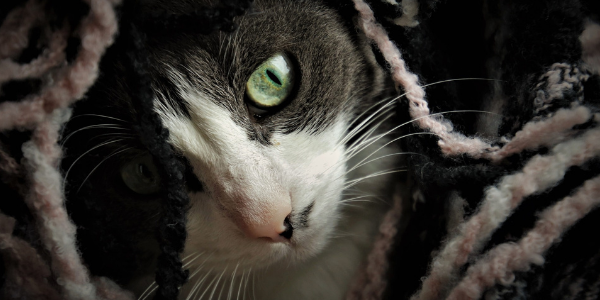
If Your Cat Has Trouble Breathing
Breathing fast is different than respiratory distress. One is an emergency, and one may not be.
An elevated respiratory rate/panting can happen if a cat is stressed. Cats almost never “pant” or open their mouth to breathe. A cat may occasionally do this after a car ride or a visit to the vet. But anytime your cat has been breathing with their mouth open for more than several minutes, it may be serious.
Respiratory distress means that the act of breathing is difficult. This is a true emergency and requires immediate attention so that your cat can be provided with supplemental oxygen and possibly medications to slow their breathing. The normal respiratory rate in a cat is between 10 to 30 breaths per minute.
To count your cat’s breathing rate, watch the belly or rib cage rise and fall when your cat is lying down. Start from zero, count for 15 seconds, and multiply by 4.
Symptoms of Respiratory Distress in Cats:
- Open-mouth breathing that is constant and not brought on by a stressful event
- Pale or bluish tinge to gums
- Gasping or coughing
- Stretching the neck out
- Abdominal breathing – the sides of the stomach appear to be moving in and out forcibly while breathing
- Foamy or frothy discharge from the mouth or nose
What to Do if Your Cat Has Difficulty Breathing
During an episode of respiratory distress, try to keep yourself calm and try to keep your pet calm. Talk to them in a soothing voice. Place your cat in a carrier and cover it partially with a towel. Bring any medications your cat is on with you to the vet.
Having a family member or neighbor call ahead to the vet can help the hospital be more prepared for your arrival.
Questions? To chat with a veterinarian about whether your cat should be taken to the emergency vet, Click here
If Your Cat Has Ingested Poison or Toxins
This is a broad topic, and while some toxins may cause minor digestive upset, others can be lethal if not treated immediately. Cats are especially sensitive to over-the-counter (OTC) medications such as Advil® and Tylenol® and should NEVER be given these medications.
If you know or see your cat ingest a toxin, you can call your vet, emergency clinic, or a pet poison control hotline and ask for their advice. They will let you know if the toxin ingested is something that needs urgent attention. There is a fee for the poison control hotline.
If you have it, be sure to take the container the toxin was in with you when you go to the vet or ER. Or grab a photo of the ingredient label to show them. If you suspect toxin ingestion and your cat is vomiting, bring a sample of the vomit with you to help your vet identify the toxin.
Do not EVER attempt to induce vomiting in a cat with hydrogen peroxide. Cats can aspirate easily (swallow the vomit into their lungs when it comes back up), and this may cause more problems than the actual toxin.
Most Common Cat Toxicities That Require Immediate Care
- OTC and prescription medications: Advil®, Tylenol®, antidepressants, vitamins, and birth control pills – these can all be toxic to your cat.
- Human foods like grapes, onions, and garlic can all cause serious toxicities in cats.
- Chocolate – luckily, cats rarely ingest chocolate on their own because they lack the taste receptors for sweets, but it is toxic if eaten and does require prompt attention.
- Veterinary medications – even those drugs prescribed to make your pet better can cause serious issues when ingested in large amounts.
- Household items: cleaning products, paint, and laundry detergent should all be kept out of pets' reach.
- Plants – some plants only cause digestive upset like vomiting or diarrhea. Others, like the Sago Palm, Lilies, and Azaleas, can cause severe organ damage if not treated immediately. Check out this list of more plants that are toxic to cats.
- Rodenticides – rat and mouse bait are usually sweet-tasting to both rodents and pets and, if not treated immediately, can cause serious bleeding issues.
If Your Cat Has Eye Problems or an Eye Injury
While a non-painful eye with a small amount of discharge is not a veterinary emergency, some eye issues require immediate care. Knowing the difference is essential.
Signs That Your Cat's Eye Issue Is an Emergency:
- Pain – evidenced by pawing at the eye, squinting, sensitivity to light
- Swelling of the eyelids accompanied by redness and or discharge, especially yellow or green in color
- The sclera (whites of the eyes) are extremely red, accompanied by symptoms of pain noted above
- One pupil is a different size than the other
- A sudden change in color to one or both eyes
With eye emergencies, it is best to get your cat seen by a veterinarian ASAP. You can place an Elizabethan (cone) collar to prevent your cat from causing more trauma to a painful eye by rubbing it until they can be seen.
If Your Cat is Unable to Urinate
If your cat cannot pass urine, that is an emergency! You should contact your veterinarian or emergency clinic immediately. This is an issue almost exclusive to male cats. Male cats can become blocked if crystals or stones become lodged in their urethra.
It is very rare for a female cat to be “blocked.” Female cats may strain to urinate if they have a urinary tract infection, crystals in their urine, or bladder stones. They should still be examined as soon as possible, but it is rarely an emergency.
Symptoms Your Cat May Have a Urethral Blockage or an Inflammatory Process Making Urination Difficult or Painful:
- Straining to urinate but producing no urine
- Sitting in the litter box and vocalizing while attempting to urinate
- Licking at their genitals frequently
- Vomiting and lethargy (no energy)
- Bloody urine or urinating outside the litter box
Complete blockage of the urinary tract in a cat can cause death in as little as 24 hours and is an immediate emergency.
If Your Cat Has a Seizure
A seizure is described as shaking, tremors, or uncontrolled spasms. It can include paddling with their legs and sometimes loss of bowel or urinary control. While always scary to witness, a single seizure episode lasting less than two minutes is not necessarily an emergency. Staring into space or biting at the air can be a minor seizure-type activity that still warrants an exam, but it’s not an emergency.
Signs That a Cat's Seizure Is Cause for Emergency Care:
- The seizure is lasting for more than 2 to 3 minutes
- Multiple seizures happening in a 24-hour period (called “cluster seizures”)
- Your cat does not seem to “come out of it” and is not “back to normal” after the episode
- Any seizure that is associated with a toxin ingestion
If your cat is seizing and will not stop, you can try turning down the lights and placing them in a carrier on a towel. Do not put your hand in your cat’s mouth – they will NOT swallow their tongue. Talk to them in a soothing voice and make sure they are not able to fall off anything, like a bed or couch.
Questions? To chat with a veterinarian about whether your cat should be taken to the emergency vet, Click here

If Your Cat Has an Allergic Reaction
Luckily, most allergic reactions in cats are mild (itchiness, mild swelling of eyes or muzzle) and are not life-threatening. But cats can have severe anaphylactic reactions just like people.
The most common causes of these types of severe reactions are bee or wasp stings, spider bites, medications, or even vaccines. A true anaphylactic reaction requires absolute immediate attention from your veterinarian or the Animal ER hospital.
Signs of an Allergic/Anaphylactic Reaction in Your Cat:
- Sudden collapse
- Facial swelling
- Swollen eyes
- Pale or bluish mucous membranes
- Difficulty breathing
- Seizures
This is only a partial list of some of the more common cat emergencies. You are the best judge of your pet’s health. If you think something is an emergency, then it is, and the best thing you can do is call your vet or emergency clinic. They are there to help decide if your pet should be seen immediately. It is always better to be safe and have things checked out rather than wait.
It could mean the difference between life and death for your beloved animal companion.



